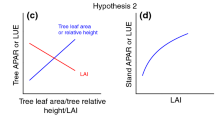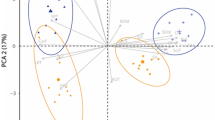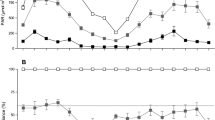Abstract
Although the tussock growth form of caespitose graminoids is widespread, the effect of this growth form on light interception and carbon gain of tillers has received little attention. Daily incident photosynthetic photon flux density (PFDinc) and carbon gain in monospecific stands of tussock grasses were compared with those of a hypothetical distribution with the equivalent tiller density per total ground area, but evenly distributed rather than clumped in tussocks. This was computed for two tussock grasses Pseudoroegneria spicata (Pursh) A. Löve (bluebunch wheatgrass) and Agropyron desertorum (Fisch, ex Link) Schult. (creasted wheatgrass) at different plant densities. Daily PFDinc and net photosynthesis (A) were greater if tillers were distributed uniformly rather than clumped in tussocks, except when the density of tussocks was so great as to approach a uniform canopy. When tussock density per ground area was low, much of the difference between tussock and uniform tiller densities in PFDinc and A was due to shading within the tussocks; up to 50–60% of the potential carbon gain was lost in A. desertorum due to shading within tussocks. In a matrix of tussocks, the light field for establishing seedlings was very heterogeneous; potential A ranged from 7 to 96% relative to an isolated seedling. The mean of daily PFDinc and A for seedlings in a tussock stand were nearly identical to the values in corresponding stands of uniform tiller distributions. It is hypothesized that the loss of A resulting from clumping tillers into tussocks is offset by benefits of protecting sequestered belowground resources from invasion by seedlings of competitors.
Similar content being viewed by others
References
Beyschlag W, Ryel RJ, Dietsch C (1994) Shedding of older needle age classes does not necessarily reduce photosynthetic primary production of Norway spruce. Analysis with a three-dimensional canopy photosynthesis model. Tress 8:132–138
Briske DD, Butler JL (1989) Density-dependent regulation of ramet populations within the bunchgrass Schizachyrium scoparium: interclonal versus intraclonal interference. J Ecol 77:963–974
Caldwell MM, Richards JH, Johnson DA, Nowak RS, Dzurec RS (1981) Coping with herbivory: Photosynthetic capacity and resource allocation in two semiarid Agropyron bunchgrasses. Oecologia 50:14–24
Caldwell MM, Dean TJ, Nowak RS, Dzurec RS, Richards JH (1983) Bunchgrass architecture, light interception, and wateruse efficiency: assessment by fiber optic point quadrats and gas exchange. Oecologia 59:178–184
Colvill KE, Marshall C (1981) The patterns of growth, assimilation of 14CO2 and distribution of 14C-assimilate within vegetative plants of Lolium perenne at low and high density. Ann Appl Biol 99:179–190
Dodd JD, Van Amburg GL (1970) Distribution of Cs134 in Andropogon scoparius Michx. clones in two native habitats. Ecology 51:685–689
Hook PB, Burke IC, Lauenroth WK (1991) Heterogeneity of soil and plant N and C associated with individual plants and openings in North American shortgrass prairie. Ecol Soc Am Bull 72:144
Jackson RB, Caldwell MM (1993) Geostatistical patterns of soil heterogeneity around individual perennial plants. J Ecol 81:683–692
Klimeš L (1992) The clone architecture of Rumex alpinus (Polygonaceae). Oikos 63:402–409
Kroon H de, Schieving F (1991) Resource allocation patterns as a function of clonal morphology: a general model applied to a foraging clonal plant. J Ecol 79:519–530
Moore CWE (1964) Distribution of grasslands. In: Barnard C (ed) Grasses and grasslands. MacMillan, London, pp 182–205
Nobel PS (1981) Spacing and transpiration of various sized clumps of a desert grass, Hilaria rigida. J Ecol 69:735–742
Nobel PS, Franco AC (1986) Annual root growth and intraspecific competition for a desert bunchgrass. J Ecol 74:1119–1126
Ong CK, Marshall C (1979) The growth and survival of severely shaded tillers in Lolium perenne L. Ann Bot 43:147–155
Robberecht R, Mahall BE, Nobel PS (1983) Experimental removal of intraspecific competitors — effects on water relations and productivity of a desert bunchgrass, Hilaria rigida. Oecologia 60:21–24
Ryel RJ, Barnes PW, Beyschlag W, Caldwell MM, Flint SD (1990) Plant competition for light analyzed with a multispecies canopy model. I. Model development and influences of enhanced UV-B conditions on photosynthesis in mixed wheat and wild oat conopies. Oecologia 82:304–310
Ryel RJ, Beyschlag W, Caldwell MM (1993) Foliage orientation and carbon gain in two tussock grasses as assessed with a new whole-plant gas-exchange model. Funct Ecol 7:115–124
Walker J, Sharpe PJH, Penridge LK, Wu H (1989) Ecological field theory: the concept and field tests. Vegetatio 83:81–95
Walter H (1979) Vegetation of the Earth and ecological systems of the geobiosphere. Springer, New York
Welker JM, Briske DD (1992) Clonal biology of the temperate, caespitose, graminoid Schizachyrium scoparium: a synthesis with reference to climate change. Oikos 63:357–365
Welker JM, Rykiel EJ, Briske DD, Goeschl JD (1985) Carbon import among vegetative tillers within two bunchgrasses: Assessment with carbon-11 labelling. Oecologia 65:209–212
Welker JM, Briske DD, Weaver RW (1987) Nitrogen-15 partitioning within a three generation tiller sequence of the bunchgrass Schizachyrium scoparium: response to selective defoliation. Oecologia 24:330–334
Welker JM, Briske DD, Weaver RW (1991) Intraclonal nitrogen allocation in the bunchgrass Schizachyrium scoparium Hubb: an assessment of the physiological individual. Funct Ecol 5:433–440
Williams DG, Briske DD (1991) Size and ecological significance of the physiological individual in the bunchgrass Schizachyrium scoparium. Oikos 62:41–47
Wu H, Sharpe PJH, Walker J, Penridge LK (1985) Ecological field theory: a spatial analysis of resource interference among plants. Ecol Modelling 29:215–243
Author information
Authors and Affiliations
Rights and permissions
About this article
Cite this article
Ryel, R.I., Caldwell, M.M. & Beyschlag, W. Light field heterogeneity among tussock grasses: Theoretical considerations of light harvesting and seedling establishment in tussocks and uniform tiller distributions. Oecologia 98, 241–246 (1994). https://doi.org/10.1007/BF00324210
Received:
Accepted:
Issue Date:
DOI: https://doi.org/10.1007/BF00324210




